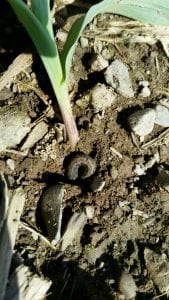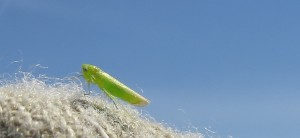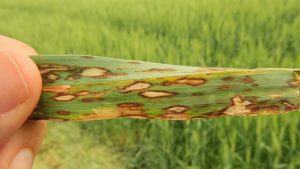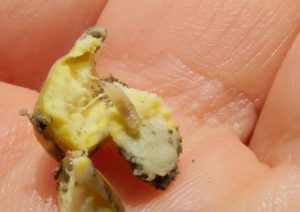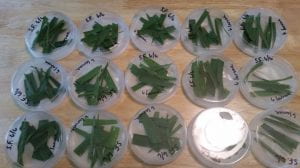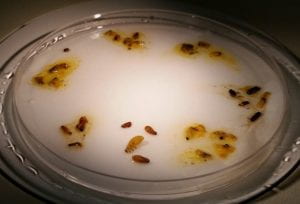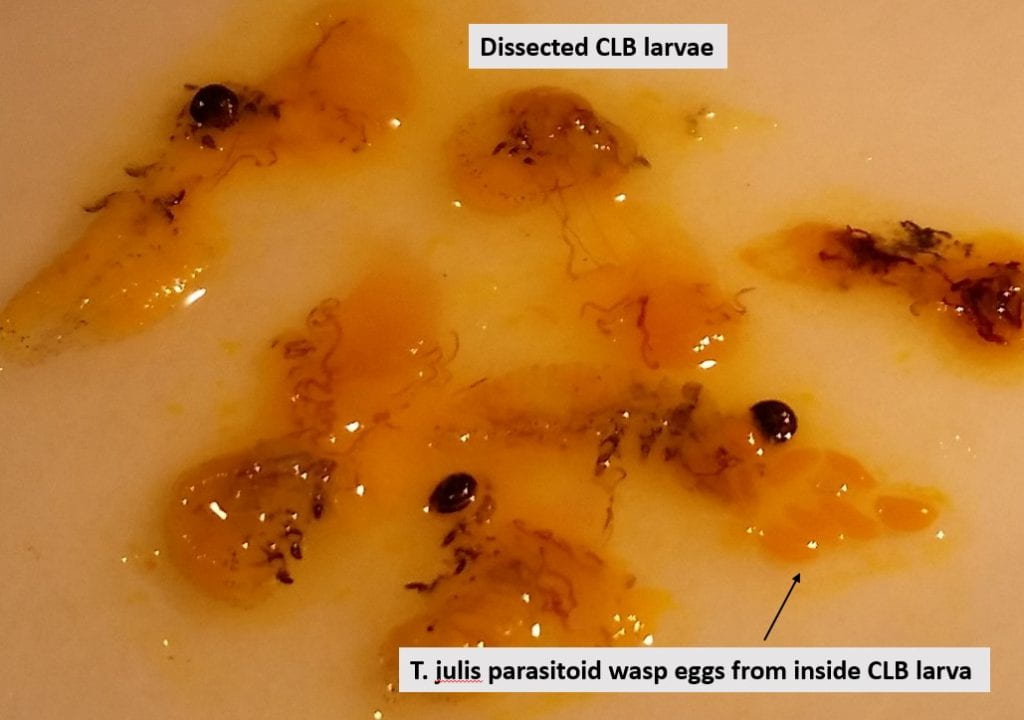NYS IPM Weekly Field Crops Pest Report, June 22, 2019
Volume 18: Number 8
View from the Field
There is a lot of black cutworm (Agrotis ipsilon) over threshold in field corn across the state. It is time to check your fields. In some cases black cutworm are so numerous they are behaving similar to true armyworm: meaning that they may move to other fields and possibly feed during the day. Again, it is best to get out and scout for them to at least the V6 stage of growth in corn every few days when at very high levels. The threshold is if 5% of plants have been damaged or cut off at the base. There can be mixed sizes of larvae in the fields. Large larvae (1.25 inches) will pupate soon and not be a problem, but small ones will go through more molts (instars) and continue to feed. Dr. Mike Stanyard, Cornell Field Crops Specialist in Northwestern NY, has a good video on scouting for black cutworm: https://vimeo.com/130331770
There are many reports of true armyworm in small grains. Please view the article below on true armyworm IPM.
Potato leafhopper (Empoasca fabae) are being found at moderate levels in alfalfa across the state. Potato leafhopper populations can increase quickly when conditions are right. Remember to scout alfalfa every week to 10 days to monitor potato leafhopper populations. Also, remember that partially harvested fields contain reservoirs for this pest which then can infest the portion of the field that is cut. Damage can occur more quickly in short alfalfa than tall.
Here is the link to a video on how to scout for PLH: https://www.youtube.com/watch?v=8BIZYTq7Zec&t=1s
There are some reports of low levels of leaf rust in wheat and barley, and higher levels of powdery mildew and spot blotch in malting barley. There are also reports of low to extremely high levels of scald in malting barley.
Cereal leaf beetle are infesting many wheat fields in western NY. Many fields have been sprayed because they reached the economic threshold. Second-generation cereal leaf beetle are also at high infestation levels in spring oats. Many oat fields will likely be sprayed in Western NY.
There is at least one field of soybeans in eastern NY and one in western NY that were heavily infested with seed corn maggot, causing obvious stand reductions. Both of these fields lacked the neonic seed treatments. This pest feeds on the seed before it germinates killing it. Seed corn maggot dramatically reduced plant populations in the field. Sometimes soybean plants can compensate for such damage.
Weather Outlook – June 20, 2019
Jessica Spaccio
NOAA Northeast Regional Climate Center, Cornell University
Last week temperatures ranged from near-normal to 6 degrees below normal. Precipitation has ranged from a tenth of an inch to 2 inches. Base 50 growing degree-days ranged from 40 to 120.
Flash flood concerns as heavy rain is occurring today. High pressure will work into the state on Friday, bringing dry and sunny weather for the weekend. Next chance of rain is Monday into Tuesday.
Today there will be multiple rounds of moderate to heavy rain with gusty winds and strong thunderstorms possible. Heavy rain and flash flooding are concerns for some areas. Temperatures will be in the 70s. Overnight lows will be in the 50s.
Friday will have some lingering scattered showers in the morning with clearing conditions from west to east, gusty conditions, and temperatures ranging from the 60s to 70s. Overnight temperatures will be in the low 50s.
Saturday temperatures will be in the 70s with sunny and breezy conditions. Overnight temperatures will be in the low 50s.
Sunday highs will be in the upper 70 and low 80s with increasing clouds in the afternoon. Overnight temperatures will be in the mid 50s to low 60s with showers possible.
Monday temperatures will be in the upper 70s to low 80s with moderate humidity. Overnight temperatures will be in the 60s. A frontal system will bring showers and thunderstorms Monday into Tuesday.
Tuesday highs will be in the upper 70s to low 80s. Overnight temperatures will be in the 60s.
Wednesday highs will be in the upper 70s to low 80s. Overnight temperatures will be in the 60s.
The seven-day precipitation amounts will range from ¾ ” to 2 ½ ” .
The 8-14 day outlook (June 27 – July 3) favors above-normal temperatures and below-normal precipitation for the entire state.
National Weather Service watch/warnings map
Cereal Leaf Beetle Biocontrol Project Underway
Jaime Cummings, Ken Wise and Amara Dunn, NYS IPM
Cereal leaf beetle damage on the flag leaf of a winter wheat plant. (Photo by J. Cummings, NYS IPM)
The cereal leaf beetle (CLB), Oulema melanopus, can be a significant pest of winter and spring small grains production in NY, especially in parts of western NY. This invasive species was first detected in Michigan in 1962, and has since become established in many grain producing states in the US, despite quarantine and pesticide eradication efforts in the 1960’s and 1970’s.
Figure 1. Cereal leaf beetle adult and larval stages. (Photos by J. Cummings, NYS IPM)
You may be familiar with this pest either in the larval or beetle stage (Fig. 1). CLB has one or two generations per growing season, and the adults overwinter in hedgerows, woods or field margins. We usually start seeing the adults move into small grains fields in April or May to lay eggs which develop into the damaging larvae. The larger the larvae get, the more damage they inflict on the crop. After about two weeks of feeding, the larvae drop to the ground and pupate for about two weeks before the adults emerge again. When looking for these pests, keep an eye out for the typical larval feeding damage that looks like strips of green tissue missing between leaf veins. Severely damaged leaves may appear skeletonized, and intense feeding pressure in a field may result in a ‘frosted’ appearance of flag leaves (Fig. 2).
Figure 2. Severe cereal leaf beetle larval feeding on winter wheat. (Photo by J. Cummings, NYS IPM)
Considering that the top two leaves of the wheat/barley/oat crop are what contributes most to grain yield, severe infestations of CLB can significantly impact yield and grain quality. Even in small grain or mixed stand forage crops, this pest can have negative effects on the yield and quality of the forage because they can significantly reduce leaf area and photosynthetic capability of the crop. It’s important to scout for this pest, usually starting in early to mid-June when larvae are first appearing. The economic threshold for insecticide application for CLB is when you count an average of three or more larvae per plant before the boot stage or one or more larvae per flag leaf after the boot stage. Occurrence of this pest can be inconsistent within a field, therefore plan to scout weekly and walk a random pattern throughout each field stopping at 10 random locations to count larvae on 10 plants at each location. Because insecticides labeled for CLB target the larval stages, in order for your pesticide applications to be most effective, make sure that at least 25% of CLB eggs have hatched and that larvae are present and actively feeding when you decided to spray. And, if you’re seeing adults in late June or beyond, it’s probably too late to spray for the larvae. (Always follow label recommendations and restrictions when applying pesticides)
Paying attention to CLB populations in your fields via scouting is an important part of an integrated management approach for minimizing losses to this pest. A growing degree day (GDD) model for CLB developed in Michigan determined that adult CLB begin to emerge around 350-400 GDD (base 48) to begin egg laying. Unfortunately, there is no specific host plant resistance available for CLB, but there are natural predators of the larvae and eggs which can help to keep the pest population in check, and possibly below the economic threshold when well-established in an area. Lady beetles are known to prey on CLB larvae and eggs, and there is at least one egg parasite though it is not widely distributed. There is also a CLB larval parasitoid wasp, Tetrastichus julis, which was originally introduced from Europe as a biological control agent in Michigan in 1967 (Fig. 3). Subsequent releases into other states, including NY in 1973, have led to a sporadic establishment of this biological control parasitoid throughout small grain production areas of the US.
Figure 3. Tetrastichus julis, a parasitic wasp on a cereal leaf beetle larva. (Photo courtesy of Washington State Department of Agriculture)
Given that CLB damage can be widespread and undermanaged in many small grains fields in NYS, and under the advice of Dr. Elson Shields (Cornell University Field Crops Entomologist), the NYS IPM program decided to try to determine the parasitism levels of CLB larvae in various locations around the state and to try to increase populations of the parasitoid in the Aurora area of Cayuga County, where the CLB tends to be a perennial pest. The multiyear project was initiated this year, with CLB larval collections from locations in six counties. However, there were no CLB present to collect at two of the locations, so the data collected in 2019 includes only four locations (Table 1). At each location, a target of approximately 100 CLB larvae of all different sizes/growth stages were collected by hand from wheat, barley or oat fields. The larvae were temporarily reared in incubation chambers on host plant leaves until approximately half of the larvae were dissected to determine baseline parasitism levels for each location (Fig. 3). The eggs of the parasitoid are visible when the CLB larvae are cut open under a microscope (Fig. 4). After baseline parasitism levels were determined for each collection location, the other half of the CLB larvae were then released at the Cornell Musgrave research farm near Aurora, NY (Fig. 5). This process will be repeated over the next few years.
Figure 3. Cereal leaf beetle rearing chambers and dissection process. (Photo by J. Cummings, NYS IPM)
Figure 4. Dissected CLB larvae, and one with T. julis parasitoid eggs. (Photo by J. Cummings, NYS IPM)
Figure 5. Cereal leaf beetle larvae with known level of parasitism being released in Cayuga County (Photos by J. Thomas-Murphy, Cornell University)
Table 1. Cereal leaf beetle collection efforts for determining parasitism levels in 2019.
| Location | County | Collection date | Crop | # CLB larvae collected |
| Seneca Falls | Seneca | 6-Jun | winter wheat, rye, barley | 96 |
| Aurora/Musgrave | Cayuga | 12-Jun | spring barley | 92 |
| Ithaca | Tompkins | 12-Jun | winter wheat, rye, barley | 45 |
| Penn Yan | Yates | 13-Jun | spring oats and peas | 110 |
| Oriskany | Oneida | 11-Jun | winter wheat | 0 |
| Homer | Cortland | 10-Jun | winter wheat | 0 |
The goals of this project are to determine the established levels of the T. julis parasitoid around the state since the initial release in 1973, and to try to determine if we can increase its population at the research farm through consecutive releases. From this first year of data collection, we know that the parasitoid population is low at the research farm (6%) and at two of the collection sites (7% and 10%), but was at approximately 30% at the Ithaca collection site (Fig. 6). We also know that although there has been a need to spray insecticides to manage CLB at the research farm and near the other collection sites, there has been no need to spray for CLB at the Ithaca collection sites. It’s likely that the T. julis parasitoid population at the Ithaca site keeps the CLB population below economic threshold levels. We hope that by intentionally distributing this parasitoid into an area with known CLB problems, we can establish a robust parasitoid population that may result in a reduction of necessary insecticide sprays for this pest.
Figure 6. Percent T. julis parasitized cereal leaf beetle larvae collected from various locations.
True Armyworm (Common armyworm) Pseudaletia unipuncta in Field Crops
Keith Waldron, NYS IPM
True Armyworm moths are long-range migrants that arrive on spring storms from their southern overwintering locations. Migration is sporadic, cyclic from year to year, and difficult to predict. True armyworms are primarily a pest of plants in the grass family: forage, pasture (and lawns), corn, and wheat and other small grains. Note: Under hunger stress, these armyworms will also attack some legumes and other plants.
Armyworm moths lay their eggs on weeds or grasses along field margins, corn leaves, or small grains. Larvae hatch about a week later and develop for about three weeks. They feed mostly at night.
Larvae range from 1/8 to 1 ½ inch long. They look pale green too brownish while still small and have smooth, cylindrical bodies. Mature larvae are smooth and marked with two orange, white-bordered strips on each side.
True Armyworm Lifecycle
True Armyworm Larvae
Keep a lookout for armyworms early while larvae are still small, since large larvae do most of the feeding and quickly destroy whole stands of corn, grasses and small grains. Fields at most risk for armyworms feeding are:
- grass or mostly grass hayfields, pastures
- wheat and other small grain fields and cut hay fields
- cornfields that:
- were planted into a small grain cover crop such as rye grass
- have grassy weeds, quackgrass, crabgrass and bluegrass and other perennials
- were planted into burned down sods, have grass weed issues, no-till or reduced tillage fields, fields with crop residue
- fields near severely infested small grain and cut hay fields, and in no-tillage corn established in grain stubble or on grassy land.
True Armyworm Damage
Armyworms can move from field to field very quickly. Start scouting for the armyworms in May and repeat scouting every 3 days to 5 days. Monitor fields for armyworm larvae when they are less than 1/2 inch long.
Because armyworms feed at night, look for chewed leaves, cut stems, lodged plants, pellet-like frass on the ground, and larvae hidden under plant canopy and surface residue.
Armyworms have two (sometimes three) generations in New York. Each takes about five weeks to complete. In a normal year, late-generation impacts are usually minimal or isolated. But if you see armyworm larvae of varied sizes (1/2 inch and greater), it suggests several flights on storm fronts—meaning we may see an extended period of armyworm activity.
Most years, natural enemies—various fungal and viral diseases as well as parasites such as tachinid flies—help suppress armyworms.
Recommended economic thresholds for
Corn:
- seedling: 10 percent or more plants show damage and larvae are still present.
- whorl-stage: apply an insecticide when there are three or more larvae per plant.
Wheat:
- 5 or more larvae per linear ft of row, larvae less than 1.25 inches and not parasitized, watch for flag leaf reduction or if grain heads clipped off – yield losses, a spray before soft dough to save the remaining 3 upper leaves is generally beneficial since these tissues are still important to grain filling
Grasses:
- no specific guidelines available, need for treatment based on the level of damage observed in relation to the expected value of grass harvest
Note: control can be challenging if caterpillars are greater than one-inch long.
Is treatment necessary? Check that the insecticide is labeled for true armyworm and the crop, be it corn, wheat, grass hayfields, or similar crops. Where possible, treat only the infested portion of the field and a 20- to 40-foot border around it. Treating the border prevents armyworms from invading from an adjacent infested field. Because the larvae are active at night, apply treatments late in the day.
Several transgenic corn hybrids with certain Bt. genes are resistant. Learn more at Michigan State University: Handy Bt Trait Table for U.S. corn production.
References:
Armyworm (Pseudaletia unipuncta Haworth)
Armyworm as a Pest of Field Corn
Cornell Guide for Integrated Field Crop Management
Armyworm Damage to Field Corn and Grass Hay and Pasture
Clipboard Checklist
Keith Waldron, NYS IPM
General
*Walk fields to check general field condition, weed issues
*Watch for crop maturity, stand assessments, weed escapes, nutrient deficiencies, lodging issues
Alfalfa:
*Evaluate established legume stands for approximate days until harvest
*Monitor potato leafhopper, foliar, systemic and crown rot diseases.
*Monitor new seedings for potato leafhopper, pythium blight, phytopthora root rot.
Small Grains:
*Monitor small grains for signs of Fusarium Head Blight, foliar diseases
*Monitor grain fields for growth stage, disease issues, grain maturity, harvest timing
*Record diseases present, location and types of weed escapes
Corn:
*Monitor for mid-season corn pests including European corn borer, corn rootworm, western bean cutworm, slugs, foliar diseases such as northern corn leaf blight and gray leaf spot, weed issues, nutrient deficiencies, vertebrate damage.
Soybeans:
*Monitor for crop growth stage, soybean aphid, defoliators, foliar diseases, white mold, weed issues, vertebrate damage
Pastures:
*Check water sources, mend fences as needed.
*Check crop growth, clip pastures between grazing as needed
*Monitor for invasive species, plants harmful to livestock
*Review/Plan rotations
Equipment:
*Carry appropriate / necessary NYS DEC and EPA documents as needed: (pesticide applicators license, pesticide labels, MSDS sheets, etc.)
Storage:
* Check stored grain bins for temperature, moisture and signs of mold and insects. Aerate, core, transfer grain or treat as necessary
* Clean and disinfect empty storage bins in preparation for grain harvest
*Check forage allocation and anticipate feed program adjustments as forages from previous year are used up
*Mow around storage bins and facility to minimize pest hiding places
Dairy Cattle Barn Fly Management:
*Monitor animals and barn area for house fly, stable fly and other pest management needs including presence of rodents and birds.
*Check facilities for favorable fly breeding conditions: (organic matter + moisture): leaks in watering systems, roof gutters for leaks and potential overspill, drainage,
*Sanitation, sanitation, sanitation – clean animal resting areas, feed troughs, minimize source of moist organic matter i.e. fly breeding areas in barn and in adjacent animal loafing yard
* Continue fly monitoring: install “3X5″ index card fly speck monitoring cards throughout barn
*Use, replenish, replace fly management materials: sticky fly tapes/ribbons, insecticide baits, natural enemies (parasitoids), fly population monitoring (3 x 5) spot cards
*Consider purchase and release of Muscidifurax raptor and/or M. raptorellus natural enemies of house and stable fly pupae.
Dairy Cattle on Pasture:
*Monitor animals for presence of face flies, horn flies and stable flies. Action guidelines: face flies (average 10 per animal face), horn flies (average 50 / dairy per animal side, 200 / beef cattle per animal side), stable flies average 10 per animal (all four legs)
*Check feed bunk / water source locations for signs of stable fly breeding (moist undisturbed organic matter – spilled feed, round bales, etc.), minimize source of moist organic matter i.e. fly breeding areas in barn and in adjacent animal exercise yard.
*Check pasture for forage quality / quantity, rotate as appropriate
*Check pasture for vegetation poisonous to livestock
*Consider use of pasture fly traps to help reduce deer, horse and stable fly populations


